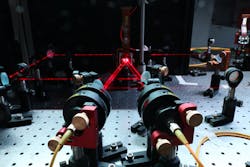Quantum light behaves differently than classical focused laser beams
A group of researchers at Tampere University in Finland are exploring the anomalous behavior of focused light fields—an effect of the physics of optical waves—within quantum light. And they’ve shown quantum light with a well-defined photon number behaves differently than classical focused laser beams. This provides new insight about the phenomena and enables super-sensitive distance measurements.
After showing certain transformations of photon pairs can produce intriguing quantum states between the transverse structures of light beams, the researchers explored whether they could engineer a quantum state within a single beam of light so the beam could be used for quantum-enhanced measurements of different parameters.
“Our initial work resulted in quantum-enhanced measurements of rotation and when looking into how this concept could be extended to longitudinal and lateral displacements, we realized that, in the longitudinal case, the Gouy phase could be the driving force behind these measurements,” says Markus Hiekkamäki, a doctoral researcher in the Experimental Quantum Optics group of the Physics Unit. “After delving into related literature, we discovered no one had really explored the effects of the Gouy phase on multiphoton quantum states and it led us to investigate the phenomenon in more detail.”
Exploring light waves within the quantum domain
The first of the three main basic phenomenon involved is the Gouy phase, the phase anomaly of waves that occurs when a beam of light is focused. “We set out to explore this fundamental feature of waves within a quantum setting, the quantum Gouy phase,” says Hiekkamäki.
The second concept they used for their experiment is photon bunching—a.k.a. Hong-Ou-Mandel interference. It essentially means photons prefer to be in the same state because of their bosonic nature. “The effect of photon bunching into the same spatial modes enables us to generate the required photon number quantum states,” he says.
And the final important concept is the increased phase response of such states, which enables the researchers to resolve the faster and more complex evolution of the quantum state due to the quantum Gouy phase.
Within the quantum domain, the researchers found anomalous behavior speeds up compared to classical light. And thanks to Gouy phase behavior, which can be used to determine the distance a beam of light has propagated, the speedup of the quantum Gouy phase may help improve precision measuring of distances.
A tool for future application of quantum states of structured light?
Significantly, the researchers found that a link between the evolution of a classical mode of electromagnetic radiation and the associated quantum states can be quite straightforward, but powerful. “Our photons are simply propagating through a focus, but such a simple linear evolution added to the discussion of more than one fundamental topic—while also providing a tool for possible future application of quantum states of structured light,” says Hiekkamäki.
The most surprising aspect of this work for Hiekkamäki is that evolution of an N-photon number states is so similar to the “Nth harmonic” of the underlying mode. “Although simply reducing the wavelength of the light field doesn’t accurately model the evolution, if we also increase the transverse mode order and adjust the beam size, a classical light field has very similar behavior to the quantum state,” he says.
Next, the group is exploring new methods of measuring and characterizing complex quantum states of multiple photons, “which will hopefully allow us to improve the tools we have for working with structured quantum states of light and also enable other fundamental studies,” says Hiekkamäki.
FURTHER READING
M. Hiekkamäki et al., Nat. Photonics (2022); https://doi.org/10.1038/s41566-022-01077-w.
About the Author
Sally Cole Johnson
Editor in Chief
Sally Cole Johnson, Laser Focus World’s editor in chief, is a science and technology journalist who specializes in physics and semiconductors.

